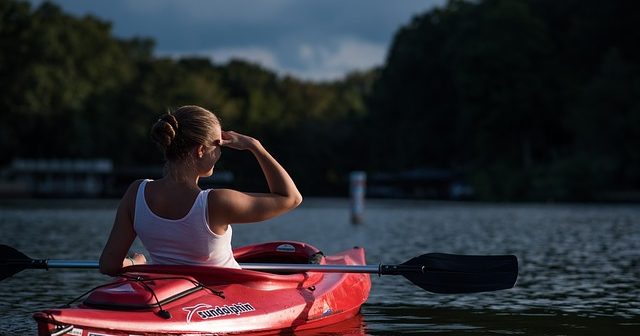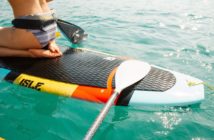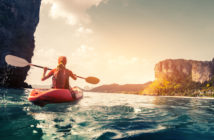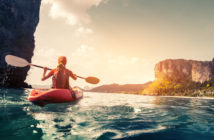Whitewater rafting enthusiasts and adventure-minded kayaking fans may choose rivers which are just right for their skill levels and preferences.
Today, we’re going to give you the inside scoop on the six levels of river difficulty.
Once you understand how rivers are classified, you’ll find it easier to decide which rivers you should explore.
Whether your whitewater rafting or kayaking skill level is beginner, intermediate or advanced, you’ll find that our comprehensive guide takes the guesswork out of river selection.
Contents
Basic Facts About River Classifications
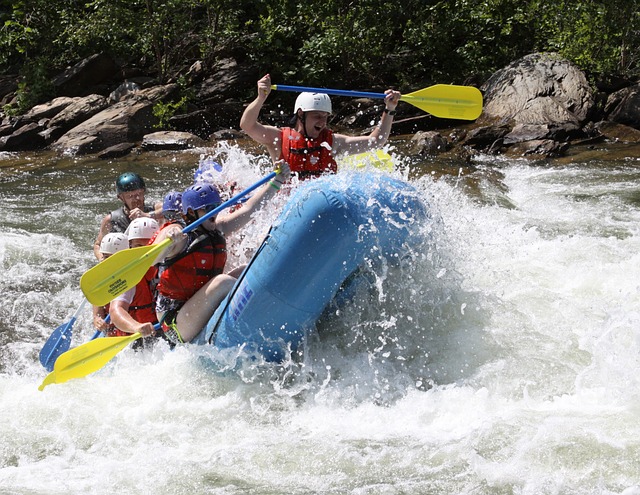
Rivers are ranked through a USA system which assesses the “international scale of river difficulty”. This American system evaluates single rapids (whitewater or not) and stretches of rivers. The classification system was invented by the AWA (American Whitewater Association) for categorizing rivers and rapids all over the globe.
This system helps whitewater kayaking fans, whitewater canoeists, stand-up paddle surfers, whitewater rafters and riverboarders to choose rivers which are ideal fits for their skills and preferences.
With this system, there is a group of six categories, which are referred to as classes or grades. Each class or grade includes a number. The scale is fixed. To cite an example of how the fixed system works, let’s say there are two Class III rivers. Both fit the general requirements for this class. However, one may be an “easy” Class III river, compared to the other, which is more challenging. They are both Class III, but a little different!
If you want to find out if a particular river or rapid is on the easier side of a specific class, or a bit more difficult, keep your eye out for a plus or minus sign next to the class number. A plus sign means “more challenging”. A minus sign means “less challenging”.
As you can see, this system is logical and very simple to understand.
Now that we’ve covered the basics, let’s move on to discussing each category on The International Scale of River Difficulty. The Classes of of rivers and rapids are Class I, Class II, Class III, Class IV, Class V and Class VI. The numbers are Roman numerals. However, you may also see rivers categorized as Class 1, Class 2, Class 3, Class 4, Class 5 and Class 6 rivers. It’s the same thing.
Class I Rivers
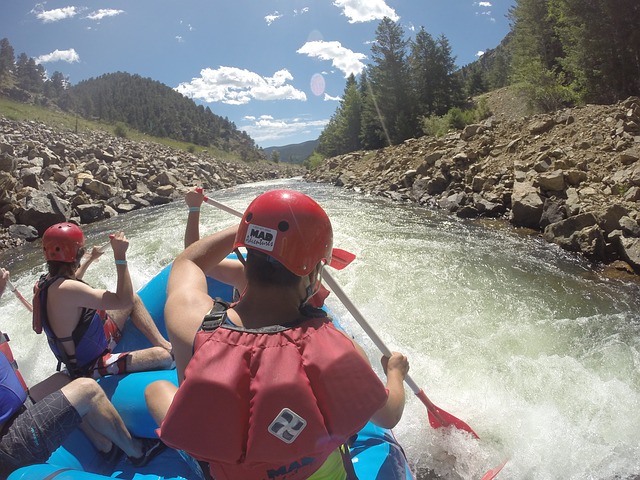
Class I is the lowest level of river difficulty. Class I destinations are ideal for those who want a safer and mellower rafting or kayaking experience.
This class is categorized as “easy”. It includes water which is fast-moving. Expect smaller waves. Riffles (shallow landforms in flowing channels) will also be present. Overall, Class I rivers and rapids don’t have too many obstructions and all of the obstructions are quite obvious to experienced rafting and kayaking enthusiasts. However, if you don’t have proper training, you may not spot these obstructions.
When you choose a Class I river, you’ll be selecting a waterway which presents only a slight risk to swimmers. The “self-rescue” level of this type of river is classified as “easy”.
A Class I river is a pretty safe place to play. It’s ideal for family fun and appropriate for beginners. Overall, with this sort of river, you’ll get a sightseeing experience, rather than thrills and chills. It’s usually possible to take pictures while rafting on a Class I river. This should help to illustrate just how calm it is, especially in relation to rivers with violent rapids, such as Class V rivers. Recreational kayaks typically function just fine on Class I rivers.
Slave River is situated in Canada’s Northwest Territories, right on the border with the province of Alberta. This scenic river features sections of Class I whitewater. The Westfield River in Massachusetts, USA also has portions of Class I River.
Outside of Canada and America, consider exploring the Msta (spelling is correct) River in Novgorod Oblast, Russia.
Class II Rivers

Class II rivers are suitable for novices. They typically features rapids which are straightforward, as well as channels which are wide and easy to see, even without scouting. While occasional maneuvers will be needed in order to navigate these types of rivers successfully, it’s usually very easy to avoid medium-scale waves and rocks. If you do have experience, you’ll have little trouble paddling around anything that you want to stay away from.
Most swimmers stay safe in Class II rivers. They rarely get hurt while they’re swimming and generally don’t require group assistance in order to get back on shore.
Rapids in this class may be on the higher end of the Class II scale. If they are, they’ll be designated as Class II +.
If you’re wondering which type of kayak is best for Class II rivers, we recommend a hybrid recreational/whitewater kayak.
One example of a Class II river is Mosquito Creek in the Western Rockies of Canada. It has Class II and Class III sections. Another example is New York’s Salmon River. Salmon River is an American waterway with sections of Class I, Class II and Class III whitewater.
For international excitement, think about a rafting or adventure kayaking trip to the picturesque Arachthos River in Greece, which has Class II to Class IV sections.
Class III Rivers

Class III is the intermediate class. When you choose to kayak or raft on this type of river, you will encounter moderate and irregular waves. These waves aren’t going to be easy to avoid! They do have the potential to swamp certain forms of boats, including open canoes. You’ll need to perform complicated maneuvers in quick currents. If you feel that you have the skills to control your vessel skillfully around ledges or in tighter passages, you may find Class III adventure very fulfilling and enjoyable.
With Class III, there will be big strainers and waves, but it’s usually simple to avoid them. As well, you should anticipate powerful currents, along with eddies which are strong. You’re more likely to run across major currents and powerful eddies if the Class III river has a big overall volume.
We recommend scouting before you get out on the water, especially if your group doesn’t have much experience. At Class III rivers, swimming injuries are rare. Also, self-rescue is typically simple. However, group assistance may be needed in order to avoid having to swim a long way to the store.
If you want to pilot a kayak rather than going rafting, consider a river runner kayak. It’s quite a popular choice for Class III waterways.
To find Class III action in the Great White North (Canada), spend some time out on the surging Kicking Horse River. It’s situated in southeastern British Columbia, within the gloriously scenic Canadian Rockies. Kicking Horse River has Class III and Class IV whitewater. In the USA, check out the North Creek of New York’s famous Hudson River. It offers Class III action, as well as Class I, II and IV whitewater.
For international Class III whitewater rafting or kayaking, test your mettle at the Lao River in Laino Borgo, Italy. It’s got Class III rapids and Class IV whitewater.
Class IV Rivers
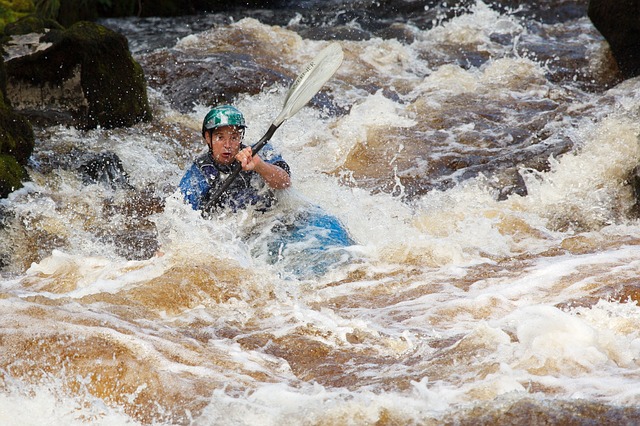
Now, we’re getting into the rough stuff. This is the advanced level of river difficulty. It’s the type of whitewater experience that adrenaline junkies crave. If you have advanced adventure kayaking or rafting skills, you may find that Class IV rivers provide the level of challenge and excitement that you’re looking for.
With Class IV, expect rapids which are powerful and intense, yet predictable. You’ll need to handle your boat precisely in this type of turbulent whitewater. Rivers in this class vary in terms of their features, but most have big waves which can’t be avoided, as well as constricted passages and holes. To deal with these challenges, you’ll need to do quick maneuvers while you’re under pressure.
Eddy turns which happen fast may be required in order to get maneuvers underway (or to rest, or to scout the whitewater). If you’re used to “must-make” moves over hazards, then Class IV rivers may be right for you.
Sometimes, scouting is necessary before first runs on these rivers. Swimmers face a moderate to high risk of getting hurt. The conditions in these waterways may make it difficult to self-rescue. Group assistance is frequently needed in order to get swimmers to shore. However, group assistance requires training.
Class IV kayakers should know how to do strong rolls.
Class IV- rapids are going to be a little easier to navigate than Class IV+ rapids. A compact touring kayak may be good enough for this type of river action. A river runner will also be a good choice. If you want to do technical maneuvers in smaller sections of rapids, consider a playboat.
Find Class IV excitement in Canada at the Ottawa River, which is located in Ottawa River Provincial Park, in the province of Ontario. It offers Class III and Class IV whitewater. An American option is New River in Thurmond, West Virginia. New River is home to whitewater rapids with Class III and Class IV designations.
If you want to explore in Europe, check out the Paiva River in Portugal. You’ll love its Class III and Class IV whitewater.
Class V Rivers
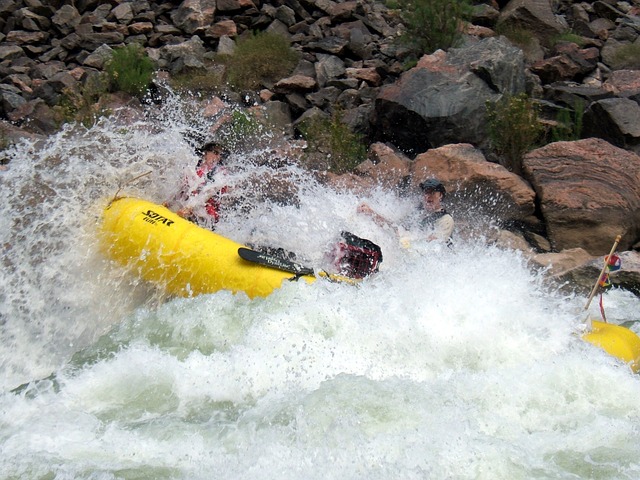
Class V rivers are for experts. They are rivers with “very violent” rapids and these rapids bring risk to paddlers. These rapids are very long and they are usually obstructed. When you take on the challenge of a Class V river, you may experience drops that come with big holes and waves which can’t be avoided, as well as congested chutes which are steep and technically demanding.
You’ll need to be very fit to handle the pressure. The rapids may feature long distances from pool to pool. If there are eddies, they will usually be turbulent and small. They may hard to reach. Class V+ rivers/rapids will have more risk factors and overall difficulty than Class V- rivers/rapids.
Scouting is a good idea but it’s often tough to do. As well, with these rivers, swimming is hazardous. Rescue is typically hard to undertake, even when experts attempt it. You’ll need appropriate equipment, a lot of experience and rescue skills that you’ve practiced time and time again.
These rivers have a slightly different scale, because they offer such a high level of river difficulty. For example, some rivers of this type may be graded 5.0, while others may be 5.2 or 5.1 or what have you. At this level of difficulty, every point matters.
Creekboats are good kayak options for Class V action.
In Canada, Quebec’s Neilson River offers Class IV and Class V action. In the US, Colorado’s Gore Canyon offers Class IV-V rapids.
For international and extreme whitewater kayaking and rafting, try the Wairoa River in New Zealand’s Bay of Plenty (if you dare). It provides Class II-V options.
Class VI Rivers

If you want the most extreme experience and you have sufficient skill and training, then you may be ready for Class VI rivers. These “exploratory and extreme” rapids are rapids that few attempt! They are extremely difficult to navigate safely. They are dangerous and unpredictable. Errors may result in severe consequences. Rescue may not even be an option.
For this reason, we think that only groups of experts should even consider rafting or kayaking on Class VI rivers. Before going out on these forms of rapids, water levels should be assessed, inspections of equipment should be performed and all precautions should be taken. If a lot of people manage to make it through this type of river, it may get a downgrade to Class V.
You’ll need the most reliable and advanced equipment. It has to be right for the most extreme conditions. If you need to ask which equipment is right for Class VI river rapids, you’re probably nowhere near ready to attempt them!
So, where to find these crazy river rapids? One option is Celestial Falls, in White River, Oregon, USA. Another is Victoria Falls, at the Zambezi River in Zimbabwe/Zambia, Africa.
Now that you know the six classes of river difficulty, why not plan a rafting or kayaking trip that suits your skill level?

